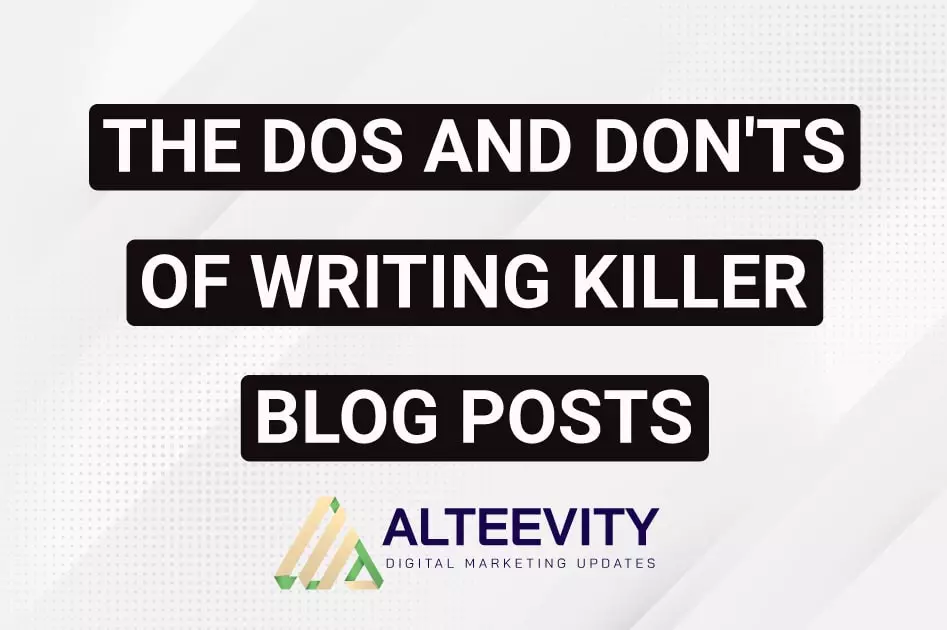Blogging is now a vital component of the digital world. With millions of blog posts published every day, it's important to create content that stands out and engages your readers. Writing a killer blog post can be a daunting task, but by following the dos and don'ts outlined in this article, you can create content that is informative, engaging, and optimized for SEO.
Dos of Writing Killer Blog Posts
- Define Your Target Audience: The first step in writing a killer blog post is to understand your target audience. Who are they? What are their interests? What are their pain points? By defining your target audience, you can tailor your content to their specific needs and interests.
- Research Your Topic: Research your topic in depth before you start the writing process. Use reliable sources, such as industry reports, academic journals, and expert blogs, to gather information and insights. This will help you create a well-informed and informative blog post.
- Use Eye-Catching Headlines: Your headline is the first thing that readers will see, so it's important to make it catchy and attention-grabbing. Use powerful words, numbers, and emotional triggers to make your headline stand out from the crowd.
- Write for Skimmers: Most readers skim blog posts, so it's important to write for skimmers. Use short paragraphs, subheadings, bullet points, and bold text to break up your content and make it easier to read.
- Use Engaging Images: Images can make your blog post more engaging and memorable. Use high-quality images that are relevant to your content and caption them with descriptive text.
- Optimize for SEO: Search engine optimization (SEO) is essential for getting your blog post found by search engines. Use keywords wisely in your title, subheadings, and content, but don’t cram them in.
Don'ts of Writing Killer Blog Posts:
- Don't Over-Promote: Your blog post should provide value to your readers, not just promote your products or services. Avoid using a sales tone and focus on providing informative and helpful content.
- Don't Plagiarize: Plagiarism is a serious offense that can damage your reputation and credibility. Respect the original authors by citing your sources and giving them credit.
- Don't Neglect Proofreading: Spelling and grammar mistakes can make your blog post look unprofessional and detract from your message. Don’t publish your content without proofreading it thoroughly first.
- Don't Ignore Formatting: Formatting is an essential part of creating a killer blog post. Use headings, subheadings, bullet points, and other formatting elements to make your content easy to read and digest.
- Don't Forget to Edit: Editing is just as important as writing. Take the time to review your content and make sure it flows well, is well-organized, and has a clear message.
Conclusion
Creating a kiIler blog post takes time and effort, but by following these dos and don'ts, you can craft content that engages and informs your readers. Remember to define your target audience, research your topic, use eye-catching headlines, write for skimmers, use engaging images, optimize for SEO, avoid over-promoting, plagiarism, neglect proofreading and formatting, and don't forget to edit.
FAQs
The ideal length for a blog post varies depending on the topic and audience. In general, blog posts that are between 1,500 and 2,000 words tend to perform well in terms of engagement and SEO.
The frequency of your blog posts will depend on your goals and resources. However, it's important to maintain a consistent publishing schedule to keep your readers engaged and attract new ones. Posting once a week or twice a month is a good starting point.
There are many ways to generate blog post ideas, such as conducting keyword research, brainstorming with your team or peers, checking out trending topics in your industry, and addressing common questions or concerns from your audience.
Yes, using humor in your blog posts can help make your content more engaging and memorable. However, make sure your humor is appropriate and relevant to your topic and audience.
SEO is essential for getting your blog posts found by search engines and driving organic traffic to your website. By using relevant keywords, optimizing your headlines and subheadings, and creating high-quality content, you can improve your blog's SEO and attract more readers.




